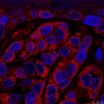(Press-News.org) University of Iowa researchers have discovered a new form of neurotransmission that influences the long-lasting memory created by addictive drugs, like cocaine and opioids, and the subsequent craving for these drugs of abuse. Loss of this type of neurotransmission creates changes in brains cells that resemble the changes caused by drug addiction.
The findings, published June 22 in the journal Nature Neuroscience, suggest that targeting this type of neurotransmission might lead to new therapies for treating drug addiction.
"Molecular therapies for drug addiction are pretty much non-existent," says Collin Kreple, UI graduate student and co-first author of the study. "I think this finding at least provides the possibility of a new molecular target."
The new form of neurotransmission involves proteins called acid-sensitive ion channels (ASICs), which have previously been shown to promote learning and memory, and which are abundant in a part of the brain that is involved in drug addiction. The researchers, led by John Wemmie, MD, PhD, professor of psychiatry in the UI Carver College of Medicine, reasoned that disrupting ASIC activity in this brain region (the nucleus accumbens) should reduce learned addiction-related behaviors. However, their experiments showed that loss of ASIC signaling actually increases learned drug-seeking in mice.
When mice learned to associate one side of a chamber with receiving cocaine, animals that lacked the ASIC protein developed an even stronger preference for the "cocaine side" than control mice, suggesting that loss of ASIC had increased addiction behavior. The same result was seen for morphine, another drug of abuse, which has a different mechanism of action than cocaine.
"Always before, the data suggested that when you get rid of ASICs, learning and memory are impaired," Wemmie says. "So we expected the same trend when we studied reward-related learning and behavior and we were surprised to find the opposite."
In a second experiment, rats learned to press a lever to self-administer cocaine. Blocking or removing ASIC in the rat brains caused the animals to self-administer more cocaine than control animals. Conversely, increasing the amount of ASIC by over-expressing the protein seemed to decrease the animals' craving for cocaine.
"There are many forms of addiction," Wemmie says. "We'd like to see if these mechanisms also apply to other addictions besides cocaine and morphine. And, we want to move forward to see if this pathway can be used to target addiction."
Protons are neurotransmitters
As the name suggests, acid-sensitive ion channels are activated by acid, in the form of protons. This research and a second UI study recently published in PNAS show that protons and ASICs form a previously unrecognized neurotransmitter pair that helps neurons communicate in a novel way; and appear to influence several forms of learning and memory, including fear, as well as addiction.
Manipulating the activity of ASICs or the level of protons (acidity) may provide a new way to treat addiction.
"We are still a long way from using these findings to create a therapy," notes Yuan Lu, PhD, co-first author and UI postdoctoral scholar. "The key significance of this study is that we have found new, different targets [that might allow us to inhibit the addiction behavior]."
Drugs change the brain
Previous research has shown that drug abuse and addiction physically alter the connections between neurons (synapses) that are important for the creation and storage of memories. Although normal learning requires synapses to be dynamic and plastic, exposure to addictive drugs abnormally increases synaptic plasticity in a way that is thought to underlie drug-related learning and addiction behaviors. The UI study found that absence of ASIC-proton mediated neurotransmission also increased synaptic plasticity in a way that resembled the changes created by addiction and drug withdrawal.
"It seemed like everything we looked at (physiology and structural changes) really paralleled what you would see in an animal undergoing drug withdrawal, even though these animals missing ASIC had never been exposed to drugs," Kreple says.
Overall the study findings suggest that ASIC-related neurotransmission in the nucleus accumbens may play a role in reducing synaptic plasticity and appropriately stabilizing synapses.
INFORMATION:
In addition to Wemmie, Kreple, and Lu, the study involved UI researchers in the Departments of Internal Medicine, Neurology, and Neurosurgery in the Carver College of Medicine, and in the Department of Psychology in the UI College of Liberal Arts and Sciences.
The study was funded by grants from the Department of Veterans Affairs, NARSAD, and the National Institutes of Health (5R01MH085724, R01HL113863, MH095972, DA034684, T32NS045549.)
New form of brain signaling affects addiction-related behavior
Protons act as neurotransmitters that affect learning and memory
2014-06-27
ELSE PRESS RELEASES FROM THIS DATE:
Homeless alcoholics typically began drinking as children
2014-06-27
WASHINGTON — A phenomenological study offers detailed insights into homeless, alcohol-dependent patients often stigmatized by the public and policymakers as drains on the health care system, showing the constellation of reasons they are incapable of escaping social circumstances that perpetuate and exacerbate their problems The study, published online yesterday in Annals of Emergency Medicine, was conducted at Bellevue Hospital in New York City, which has a long history of service to the city's indigent population.
"One hundred percent of patients enrolled in the study ...
CNIO researchers discover more than 40 melanoma-specific genes that determine aggressiveness
2014-06-27
Researchers from the Spanish National Cancer Research Centre (CNIO) have discovered more than 40 genes that predict the level of aggressiveness of melanoma and that distinguish it from other cancers with a poor prognosis. The discovery, published in Cancer Cell, will help to identify unique aspects of melanoma that could contribute to determine the risk of developing metastasis in patients with this disease. This study is relevant because it explains why a drug, also described by CNIO, is being used to selectively attack the melanoma tumour cells. Melanoma is one of the ...
NIH scientists establish proof-of-concept for host-directed tuberculosis therapy
2014-06-27
WHAT:
In a new study published in Nature, scientists describe a new type of tuberculosis (TB) treatment that involves manipulating the body's response to TB bacteria rather than targeting the bacteria themselves, a concept called host-directed therapy. TB remains a major cause of disability and death worldwide as an estimated 8.6 million people fell ill with TB and 1.3 million people died from the disease in 2012, according to the World Health Organization. Although TB is curable, adherence to therapy is difficult as treatment requires taking antibiotic drugs for at least ...
Walking the rocks: GSA Today article studies undergraduate field education
2014-06-27
Boulder, Colorado, USA – In the July 2014 issue of GSA Today, Heather Petcovic of Western Michigan University and colleagues Alison Stokes and Joshua Caulkins examine the question of geoscientists' perceptions of the value of undergraduate field education. Despite being perceived as integral to both geoscience learning and professional preparation, little research exists on the types of field experiences that carry the most value.
In their study, Petcovic and colleagues compile and analyze survey data obtained during two Geological Society of America (GSA) annual meetings ...
Research provides new theory on cause of ice age 2.6 million years ago
2014-06-27
New research published today (Friday 27th June 2014) in the journal Nature Scientific Reports has provided a major new theory on the cause of the ice age that covered large parts of the Northern Hemisphere 2.6 million years ago.
The study, co-authored by Dr Thomas Stevens, from the Department of Geography at Royal Holloway, University of London, found a previously unknown mechanism by which the joining of North and South America changed the salinity of the Pacific Ocean and caused major ice sheet growth across the Northern Hemisphere.
The change in salinity encouraged ...
Scientists identify new pathogenic and protective microbes associated with severe diarrhea
2014-06-27
In a finding that may one day help control a major cause of death among children in developing countries, a team of researchers led by faculty from the University of Maryland, College Park and the University of Maryland School of Medicine has identified microorganisms that may trigger diarrheal disease and others that may protect against it. These microbes were not widely linked to the condition previously.
"We were able to identify interactions between microbiota that were not previously observed, and we think that some of those interactions may actually help prevent ...
Genetics dominant risk factor in common cancers
2014-06-27
A study of individuals who have been adopted has identified genetics as the dominant risk factor in 'familial' breast, prostate and colorectal cancers.
Researchers at the Centre for Primary Health Care Research at Lund University and Region Skåne in Sweden have presented the new research findings based on studies of population registers.
"The results of our study do not mean that an individual's lifestyle is not important for the individual's risk of developing cancer, but it suggests that the risk for the three most common types of cancer is dependent to a greater ...
Social pressure stops Facebook users recommending products on social media sites
2014-06-27
Facebook has more than 1.23 billion active users worldwide, with over 50 per cent of all users logging on to it on any given day. Most of Facebook's revenue comes from advertising and the company is looking at ways to make the site a more effective advertising platform for marketers. This includes selling ads that are more targeted to their users.
However, researchers have found that users of social media websites are less likely to use them to say positive things about their favourite products and services. Instead, they are more likely to express their opinions about ...
Scientists identify new pathogenic & protective microbes associated with severe diarrhea
2014-06-27
In a finding that may one day help control a major cause of death among children in developing countries, a team of researchers led by faculty from the University of Maryland, College Park and the University of Maryland School of Medicine has identified microorganisms that may trigger diarrheal disease and others that may protect against it. These microbes were not widely linked to the condition previously.
"We were able to identify interactions between microbiota that were not previously observed, and we think that some of those interactions may actually help prevent ...
Eco-friendly versatile nanocapsules developed
2014-06-26
The Institute for Basic Science (IBS) has announced that the Center for Self-assembly and Complexity have succeeded in developing a new technology that introduces metal nanoparticles on the surface of polymer nanocapsules made of cucurbit[6]uril.
The researchers have found that using polymer nanocapsules made of cucurbit[6]uril and metal salts can serve as a versatile platform where equal sized metal nanoparticles can be evenly distributed on the surface of the polymer nanocapsules. Cucurbit[6]uril has properties which strongly and selectively recognize organic and inorganic ...
LAST 30 PRESS RELEASES:
Making lighter work of calculating fluid and heat flow
Normalizing blood sugar can halve heart attack risk
Lowering blood sugar cuts heart attack risk in people with prediabetes
Study links genetic variants to risk of blinding eye disease in premature infants
Non-opioid ‘pain sponge’ therapy halts cartilage degeneration and relieves chronic pain
AI can pick up cultural values by mimicking how kids learn
China’s ecological redlines offer fast track to 30 x 30 global conservation goal
Invisible indoor threats: emerging household contaminants and their growing risks to human health
Adding antibody treatment to chemo boosts outcomes for children with rare cancer
Germline pathogenic variants among women without a history of breast cancer
Tanning beds triple melanoma risk, potentially causing broad DNA damage
Unique bond identified as key to viral infection speed
Indoor tanning makes youthful skin much older on a genetic level
Mouse model sheds new light on the causes and potential solutions to human GI problems linked to muscular dystrophy
The Journal of Nuclear Medicine ahead-of-print tip sheet: December 12, 2025
Smarter tools for peering into the microscopic world
Applications open for funding to conduct research in the Kinsey Institute archives
Global measure underestimates the severity of food insecurity
Child survivors of critical illness are missing out on timely follow up care
Risk-based vs annual breast cancer screening / the WISDOM randomized clinical trial
University of Toronto launches Electric Vehicle Innovation Ontario to accelerate advanced EV technologies and build Canada’s innovation advantage
Early relapse predicts poor outcomes in aggressive blood cancer
American College of Lifestyle Medicine applauds two CMS models aligned with lifestyle medicine practice and reimbursement
Clinical trial finds cannabis use not a barrier to quitting nicotine vaping
Supplemental nutrition assistance program policies and food insecurity
Switching immune cells to “night mode” could limit damage after a heart attack, study suggests
URI-based Global RIghts Project report spotlights continued troubling trends in worldwide inhumane treatment
Neutrophils are less aggressive at night, explaining why nighttime heart attacks cause less damage than daytime events
Menopausal hormone therapy may not pose breast cancer risk for women with BRCA mutations
Mobile health tool may improve quality of life for adolescent and young adult breast cancer survivors
[Press-News.org] New form of brain signaling affects addiction-related behaviorProtons act as neurotransmitters that affect learning and memory



